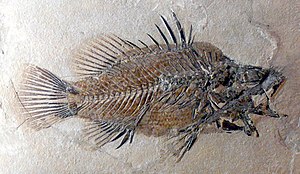Eolates
| Eolates | ||||||||||||
|---|---|---|---|---|---|---|---|---|---|---|---|---|

Fossil of Eolates gracilis in the Museum of Natural History in Berlin |
||||||||||||
| Temporal occurrence | ||||||||||||
| lower Eocene | ||||||||||||
| 56 to 47 million years | ||||||||||||
| Locations | ||||||||||||
|
Monte Bolca (Italy) |
||||||||||||
| Systematics | ||||||||||||
|
||||||||||||
| Scientific name | ||||||||||||
| Eolates | ||||||||||||
| Sorbini , 1970 | ||||||||||||
Eolates is an extinct genus of fish from the giant perch group . All known fossils of the genus come from the northern Italian Monte Bolca formation.
features
Eolates resembles the recent giant perch of the genus Lates , but remained smaller and had a higher-backed, strongly squat body. The caudal fin skeleton is more primitive than in Lates (three epuralia (elongated, free-standing bones) vs. two in Lates , but also three in Centropomus ), the dorsal fin is less deeply incised and Eolates has only one (the middle) pored row of scales ( side line ) on the caudal fin (vs. three on lates ). As with Lates , the preoperculum of Eolates has four large spines, and another large spine lies on the gill cover. The ornamentation of the cleithrum and the first infraorbital bone ( lacrimale ) is almost the same in Eolates and Lates .
- Fin formula : dorsal 1 VII, dorsal 2 I / 12, anal III / 8.
Systematics
The two species now included in the genus Eolates were described in 1833 and 1834 by the Swiss-American naturalist Louis Agassiz and placed in the genus Lates . The genus Eolates was established in 1970 by Lorenzo Sorbini. Type species is Eolates gracilis (Agassiz, 1834). The second, little-known species E. macrurus (Agassiz, 1833) might have to be synonymous with Eolates gracilis .
Eolates belongs to the family Centropomidae and there to the subfamily Latinae . Within the Latinae, Eolates is the plesiomorphic sister genus of Lates and together with this genus forms the tribe Latini, which is in a sister group relationship to the tribe Psammopercini (only genus Psammoperca ).
literature
- Karl Albert Frickhinger: Fossils Atlas Fish , Mergus-Verlag, Melle, 1999, ISBN 3-88244-018-X
- Greenwood, PH 1976. A review of the family Centropomidae (Pisces, Perciformes) . Bulletin of the British Museum (Natural History) Zoology. 29: 1-81.